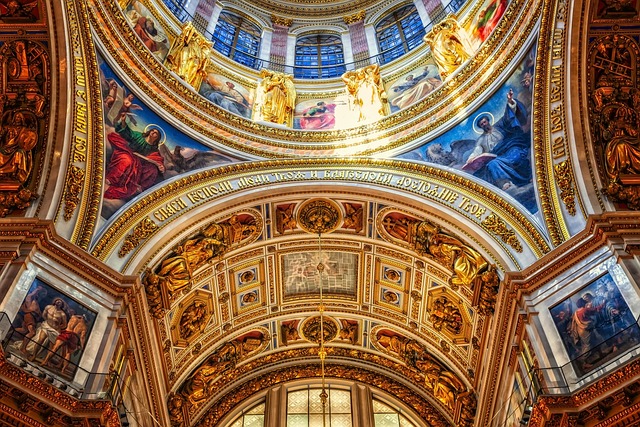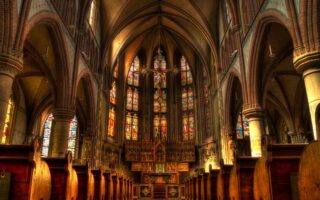Orthodox Christians celebrate Christmas in a unique and traditional manner.
Table of Contents
Traditions and Customs of Orthodox Christmas Celebrations
Orthodox Christmas is a time of joy and celebration for millions of people around the world. The traditions and customs associated with this holiday are rich and deeply rooted in history. From the way the day is observed to the special rituals that take place, Orthodox Christmas is a unique and meaningful experience.
One of the most distinctive aspects of Orthodox Christmas is the date on which it is celebrated. Unlike the Western Christian tradition, which observes Christmas on December 25th, Orthodox Christmas falls on January 7th. This is because the Orthodox Church follows the Julian calendar, which is 13 days behind the Gregorian calendar used by most of the world.
In the weeks leading up to Christmas, Orthodox believers engage in a period of fasting and prayer known as Advent. This is a time of spiritual preparation and reflection, as individuals strive to cleanse their hearts and minds in anticipation of the birth of Christ. During Advent, many Orthodox Christians abstain from meat, dairy, and other indulgences, focusing instead on prayer and acts of charity.
On Christmas Eve, Orthodox believers gather in churches for a special midnight liturgy. This service is a beautiful and solemn occasion, filled with prayers, hymns, and readings from the Bible. The atmosphere is one of reverence and awe, as worshippers come together to celebrate the birth of Jesus Christ.
After the liturgy, families return home to enjoy a festive meal. Traditional dishes vary from country to country, but common foods include roasted meats, fish, and an array of delicious desserts. In some Orthodox cultures, it is customary to leave an empty place setting at the table for any unexpected guests who may arrive. This symbolizes the spirit of hospitality and generosity that is central to the Christmas season.
Gift-giving is also an important part of Orthodox Christmas. While the focus is not on extravagant presents, many families exchange small tokens of love and appreciation. These gifts are often symbolic, representing the spiritual significance of the holiday. For example, a candle may be given to symbolize the light of Christ, or a small icon may be presented as a reminder of the divine presence in our lives.
In addition to these traditions, Orthodox Christmas is marked by a number of unique customs. In some countries, such as Russia and Ukraine, it is traditional to go caroling from house to house, spreading joy and good wishes to neighbors and loved ones. In other Orthodox communities, a special service called the Blessing of the Waters takes place on January 6th. This ceremony involves the blessing of a body of water, such as a river or lake, and is a symbolic reenactment of Christ’s baptism in the Jordan River.
Orthodox Christmas is a time of deep spiritual significance and joyful celebration. From the fasting and prayer of Advent to the midnight liturgy and festive meals, every aspect of this holiday is infused with meaning and tradition. Whether it is the exchange of gifts, the singing of carols, or the blessing of the waters, Orthodox Christmas is a time to come together as a community and honor the birth of Jesus Christ.
Symbolism and Significance of Orthodox Christmas Icons

Orthodox Christmas is a time of great joy and celebration for millions of people around the world. It is a time when families come together to honor the birth of Jesus Christ and to reflect on the significance of this event. One of the most important aspects of Orthodox Christmas is the use of icons, which hold deep symbolism and meaning for believers.
Icons are an integral part of Orthodox Christianity and are used as a means of connecting with the divine. They are not mere paintings or decorations, but rather windows into the spiritual realm. Icons are believed to be a way for believers to communicate with the saints and to experience the presence of God.
The use of icons in Orthodox Christmas celebrations is rooted in the belief that the divine can be made manifest in the material world. Icons are seen as a bridge between the earthly and the heavenly, a tangible representation of the divine presence. They serve as a reminder of the sacredness of the Christmas story and the importance of the birth of Christ.
Each icon used in Orthodox Christmas celebrations has its own unique symbolism and significance. The most common icon used during this time is the Nativity icon, which depicts the birth of Jesus in a humble stable. This icon serves as a reminder of the humility and simplicity of Christ’s birth, and the importance of finding joy in the midst of difficult circumstances.
Another important icon used during Orthodox Christmas is the icon of the Theotokos, or the Virgin Mary. This icon represents the motherhood of Mary and her role in the birth of Christ. It is a symbol of love, compassion, and devotion, and serves as a reminder of the importance of family and the nurturing of children.
The icon of the Magi, or the Wise Men, is also commonly used during Orthodox Christmas celebrations. This icon represents the journey of the Magi to visit the newborn Jesus and their recognition of his divinity. It serves as a reminder of the importance of seeking and recognizing the presence of God in our lives.
In addition to these specific icons, Orthodox Christmas celebrations often include the use of other symbols and images that hold deep meaning for believers. The use of candles, for example, represents the light of Christ shining in the darkness. The use of incense symbolizes the prayers of the faithful rising to heaven. These symbols and images help to create a sacred and reverent atmosphere during the Christmas season.
In conclusion, the use of icons in Orthodox Christmas celebrations holds deep symbolism and significance for believers. Icons serve as a means of connecting with the divine and experiencing the presence of God. They remind believers of the sacredness of the Christmas story and the importance of the birth of Christ. Each icon used during Orthodox Christmas has its own unique symbolism and serves as a reminder of different aspects of the Christmas story. The use of icons, along with other symbols and images, helps to create a sacred and reverent atmosphere during this joyous season.
Traditional Orthodox Christmas Foods and Recipes
Traditional Orthodox Christmas Foods and Recipes
When it comes to celebrating Christmas, food plays a central role in many cultures around the world. The Orthodox Christian community is no exception, with a rich culinary tradition that adds a special touch to their Christmas festivities. In this article, we will explore some of the traditional Orthodox Christmas foods and recipes that are enjoyed by families during this joyous season.
One of the most iconic dishes served during an Orthodox Christmas is the Kutia. This sweet grain pudding holds a deep symbolic meaning and is often the first dish to be served at the Christmas Eve dinner. Made with wheat berries, honey, poppy seeds, and nuts, Kutia represents the unity of the family and the hope for a prosperous year ahead. It is a dish that brings everyone together, as family members take turns stirring the pot and sharing stories of Christmases past.
Another beloved dish that graces the Orthodox Christmas table is the Borscht. This hearty beet soup is a staple in many Eastern European countries and is often served as a starter. The vibrant red color of the soup symbolizes the blood of Christ, and the warmth it brings to the body is a comforting reminder of the love and compassion that Christmas represents. Borscht is typically made with beets, cabbage, potatoes, and carrots, and can be enjoyed with a dollop of sour cream for added richness.
No Orthodox Christmas feast would be complete without the presence of a beautifully roasted pig or lamb. Roast pork or lamb is a traditional main course that signifies abundance and prosperity. The succulent meat, seasoned with aromatic herbs and spices, is a true centerpiece that brings joy to the table. The roasting process itself is a labor of love, as families gather around the fire or oven, eagerly awaiting the moment when the meat is perfectly cooked and ready to be enjoyed.
In addition to these main dishes, a variety of side dishes and desserts are also prepared to complement the Christmas feast. Pierogi, a type of dumpling filled with various ingredients such as potatoes, cheese, or sauerkraut, is a popular choice. These little pockets of goodness are often served with melted butter and sour cream, creating a delightful combination of flavors.
For those with a sweet tooth, the Orthodox Christmas table offers an array of delectable desserts. Paskha, a traditional Russian dessert, is a creamy and rich cheesecake-like dish made with cottage cheese, butter, and dried fruits. It is often shaped into a pyramid and decorated with intricate designs, symbolizing the ascent of Christ into heaven.
Another sweet treat that is enjoyed during Orthodox Christmas is the Kolach. This braided bread, often shaped into a ring, represents the circle of life and eternity. It is made with flour, yeast, eggs, and sugar, and can be flavored with various ingredients such as raisins or nuts. The Kolach is typically served as a centerpiece on the Christmas table, and family members take turns breaking off a piece, symbolizing unity and sharing.
In conclusion, the Orthodox Christmas celebration is a time of joy, love, and togetherness. The traditional foods and recipes that are prepared during this festive season hold deep symbolic meanings and bring families closer together. From the sweet grain pudding of Kutia to the succulent roast pork or lamb, each dish tells a story and adds a special touch to the Christmas feast. So, as you gather with your loved ones this Christmas, take a moment to savor the flavors and appreciate the traditions that make this holiday truly special.
The Importance of Midnight Liturgy in Orthodox Christmas Celebrations
Orthodox Christmas is a time of great joy and celebration for millions of people around the world. While the customs and traditions may vary from country to country, one common element that unites Orthodox Christians is the importance of the Midnight Liturgy in their Christmas celebrations.
The Midnight Liturgy, also known as the Divine Liturgy of the Nativity, is a special service held on the night of December 24th or early morning of December 25th. It is a time when Orthodox Christians come together to commemorate the birth of Jesus Christ and to worship as a community.
The significance of the Midnight Liturgy lies in its timing. Orthodox Christians believe that Jesus was born at midnight, and so the service is held at this specific hour to mark the exact moment of his birth. This adds a sense of reverence and anticipation to the proceedings, as the faithful gather in churches adorned with beautiful decorations and lit candles.
The Midnight Liturgy is a unique experience that engages all the senses. The air is filled with the scent of incense, creating an atmosphere of holiness and spirituality. The sound of hymns and prayers fills the church, as the choir and congregation join together in joyful song. The sight of the iconostasis, adorned with icons depicting the Nativity, serves as a visual reminder of the miracle that took place on this night.
During the service, the priest reads from the Gospel of Luke, recounting the story of the birth of Jesus in Bethlehem. This is followed by a sermon, where the priest reflects on the significance of Christ’s birth and its relevance to the lives of the faithful. The congregation listens attentively, taking in the words of wisdom and finding inspiration for their own spiritual journey.
One of the most cherished moments of the Midnight Liturgy is the singing of the Troparion of the Nativity. This hymn, sung in a solemn yet joyful tone, proclaims the good news of Christ’s birth and invites all to rejoice in the miracle of salvation. It is a moment of unity and shared faith, as the voices of the congregation blend together in harmony.
After the liturgy, the faithful gather for a festive meal known as the Holy Supper. This is a time for families to come together and share a traditional meal, which typically includes twelve dishes to symbolize the twelve apostles. The Holy Supper is a time of joy and fellowship, as loved ones exchange gifts and celebrate the birth of Christ.
The Midnight Liturgy holds a special place in the hearts of Orthodox Christians. It is a time when the community comes together to celebrate the birth of Jesus, to reflect on the meaning of his life, and to renew their faith. The service is a reminder of the importance of Christ’s birth in the lives of believers and serves as a source of inspiration and hope for the year ahead.
In conclusion, the Midnight Liturgy is a central part of Orthodox Christmas celebrations. It is a time of worship, reflection, and joy, as the faithful gather to commemorate the birth of Jesus Christ. The service engages all the senses and creates a sense of unity and shared faith among the congregation. The Midnight Liturgy is a cherished tradition that brings Orthodox Christians closer to their faith and to one another.
Conclusion
In conclusion, Orthodox Christians celebrate Christmas with a combination of religious rituals, traditions, and cultural customs. The celebration typically includes attending church services, fasting, exchanging gifts, and enjoying festive meals with family and friends. The emphasis is on the birth of Jesus Christ and the spiritual significance of the holiday.
For licensing reasons, we must provide the following notice: This content was created in part with the help of an AI.


